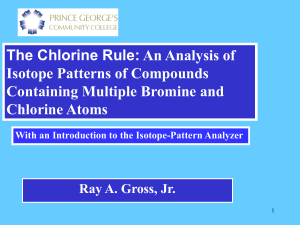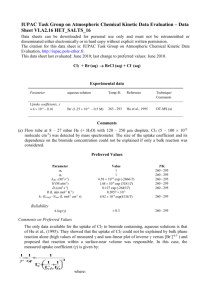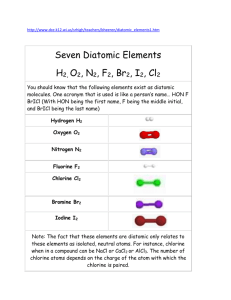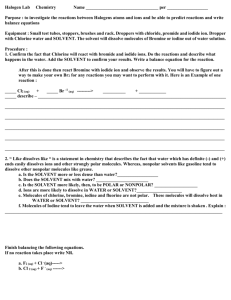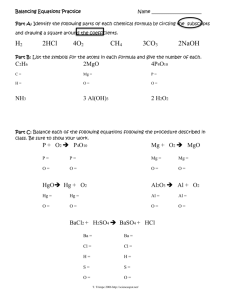Data Sheet PBr8 - IUPAC Task Group on Atmospheric Chemical
advertisement
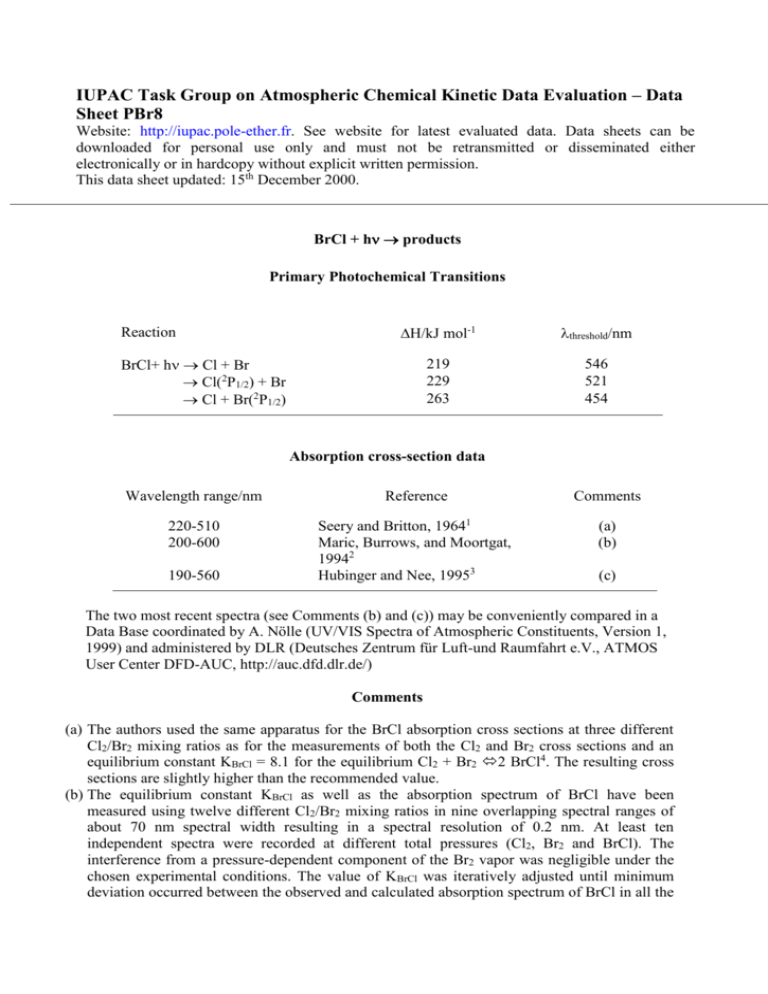
IUPAC Task Group on Atmospheric Chemical Kinetic Data Evaluation – Data Sheet PBr8 Website: http://iupac.pole-ether.fr. See website for latest evaluated data. Data sheets can be downloaded for personal use only and must not be retransmitted or disseminated either electronically or in hardcopy without explicit written permission. This data sheet updated: 15th December 2000. BrCl + h products Primary Photochemical Transitions Reaction H/kJ mol-1 threshold/nm 219 229 263 546 521 454 BrCl+ h Cl + Br Cl(2P1/2) + Br Cl + Br(2P1/2) Absorption cross-section data Wavelength range/nm Reference Comments 220-510 200-600 Seery and Britton, 19641 Maric, Burrows, and Moortgat, 19942 Hubinger and Nee, 19953 (a) (b) 190-560 (c) The two most recent spectra (see Comments (b) and (c)) may be conveniently compared in a Data Base coordinated by A. Nölle (UV/VIS Spectra of Atmospheric Constituents, Version 1, 1999) and administered by DLR (Deutsches Zentrum für Luft-und Raumfahrt e.V., ATMOS User Center DFD-AUC, http://auc.dfd.dlr.de/) Comments (a) The authors used the same apparatus for the BrCl absorption cross sections at three different Cl2/Br2 mixing ratios as for the measurements of both the Cl2 and Br2 cross sections and an equilibrium constant KBrCl = 8.1 for the equilibrium Cl2 + Br2 2 BrCl4. The resulting cross sections are slightly higher than the recommended value. (b) The equilibrium constant KBrCl as well as the absorption spectrum of BrCl have been measured using twelve different Cl2/Br2 mixing ratios in nine overlapping spectral ranges of about 70 nm spectral width resulting in a spectral resolution of 0.2 nm. At least ten independent spectra were recorded at different total pressures (Cl2, Br2 and BrCl). The interference from a pressure-dependent component of the Br2 vapor was negligible under the chosen experimental conditions. The value of KBrCl was iteratively adjusted until minimum deviation occurred between the observed and calculated absorption spectrum of BrCl in all the regions of overlap: KBrCl = 10.1 ± 1.1 at 298K leads to a third law value of H0f = 14.31 kJ/mol. (c) Mixtures of Cl2 and Br2 in 670 mbar of Ar were prepared in an evacuable gas flow line. The equilibrium concentrations have been obtained using KBrCl = 6.45. The low pressures used in the present study (0.2 to 12.0 mbar) minimized the interference of Br2 dimers. The limit to the red at >500 nm is given by instrument noise. Graphical comparison between the measured spectrum and the results from the literature1,2 shows only minor differences. The BrCl spectrum was deconvoluted using a semi-logarithmic gaussian distribution function into four components with maxima at 228.33 (UV band), 376.39 (C11), 454.92 (B30+) and 533.05 nm (A31). No Quantum Yield Data available Absorption Cross Sections at 298K /nm 200 210 220 230 240 250 260 270 280 290 300 310 320 330 340 350 360 370 380 390 400 1020 /cm2 2.95 4.27 6.31 6.61 5.62 4.07 5.50 1.29 0.66 0.39 0.56 1.51 4.07 9.12 17.00 28.18 34.67 41.69 39.81 33.88 28.18 /nm 410 420 430 440 450 460 470 480 490 500 510 520 530 540 550 560 570 580 590 600 1020 /cm2 22.39 17.78 14.45 12.59 10.72 9.33 7.94 6.31 5.01 3.39 2.63 1.66 1.10 0.66 0.41 0.25 0.144 0.832 0.0479 0.0251 Comments on Preferred Values The data of Maric et al.2 are recommended because it is the most comprehehsive data set to date available which is internally consistent using an equilibrium constant KBrCl = 10.1 ± 1.1 at 298K which is measured in the same study. The absorption cross sections of BrCl agree in the regions of overlap between the spectral fragments to better than ± 2%, and it is estimated that the accuracy is better than ± 3% in the range = 200–550 nm. In the range 550-600 nm the agreement between spectral fragments is better than ± 15% for an overall accuracy in this range of better than ± 20%. Spectral deconvolution in terms of three contributing bands with maxima at 227.6, 372.5 and 442.4 nm has been obtained. Combining the values of BrCl with the results of Sulzer and Wieland6 obtains the temperature and wavelength dependence of the UV/Vis absorption spectrum of BrCl. A quantum yield of unity for the dissociation of BrCl is expected. References 1 D. J. Seery and D. Britton, J. Phys. Chem. 68, 2263 (1964). D. Maric, J. P. Burrows, and G. K. Moortgat, J. Photochem. Photobiol. A: Chem., 83, 179 (1994). 3 S. Hubinger and J. B. Nee, J. Photochem. Photobiol. A: Chem., 86, 1 (1995). 4 W. H. Evans, T. R. Munson, and D. D. Wagman, J. Res. Natl. Bur. Std., 55, 147 (1955). 5 H. C. Mattraw, C. F. Packucki, and N. J. Hawkings, J. Chem. Phys. 22, 1117 (1954). 6 P. Sulzer and K. Wieland, Helv. Phys. Acta, 25, 653 (1952). 2
